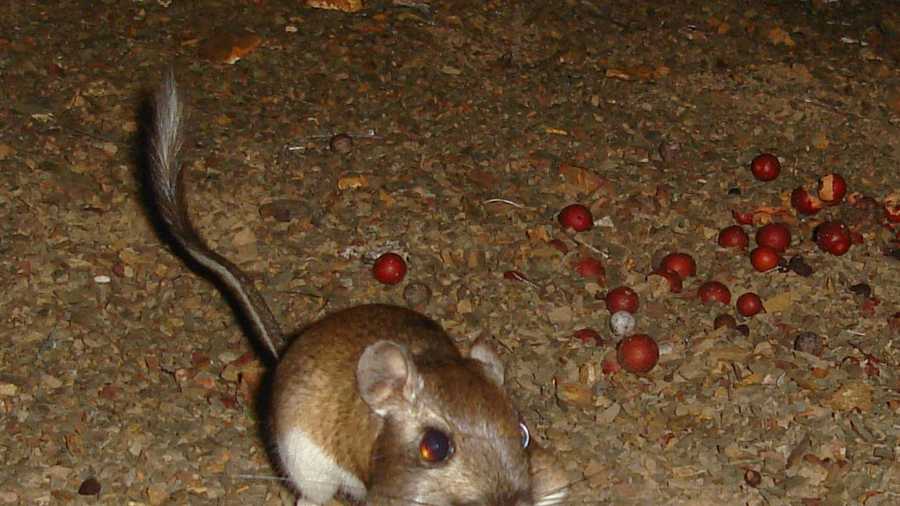'Critically imperiled' species seen in California for first time in 75 years
The animal in question hadn't been seen in the area in more than 75 years and was listed as a "critically imperiled subspecies."
The animal in question hadn't been seen in the area in more than 75 years and was listed as a "critically imperiled subspecies."
When a photo of a burrow-dwelling critter with an unusually long tail was captured by a trail camera in the rugged mountains of the Sierra Azul Open Space Preserve outside of San Jose, California, in 2019, researchers were baffled. The animal in question — a Santa Cruz kangaroo rat — hadn't been seen in the area in more than 75 years and was listed by the California Department of Fish and Wildlife as a "critically imperiled subspecies," meaning it was at risk of becoming extinct.
The Santa Cruz kangaroo rat, which is closely related to chipmunks and gophers, gets its name from the massive hind legs it uses to hop around. Like a kangaroo, the critter also has pouches, but instead of using them to carry babies, they come in handy as a kind of built-in storage unit in their cheeks that they use while foraging for food.
Photographer and ecologist Ken Hickman discovered the presence of the elusive rodent in 2019, using his own custom-designed and -built wildlife cameras. This April, a group of Midpeninsula Regional Open Space District wildlife biologists and UC Santa Cruz researchers set out before dawn on an expedition throughout the preserve to see if they could find proof of other individuals.
After three days of searching using baited metal traps that were laid throughout the kangaroo rat's habitat, only four of the animals were found — a testament to just how rare they are. Biologists collected data, including the size of each specimen, before releasing the rodents back into the wild.
"We were all just so elated, because it's something we'd definitely been aware of as a possibility, but we've seen a lot of these populations that used to be in the Santa Cruz mountain region wink out over time," Midpen wildlife biologist and project manager Matt Sharp Chaney said. "I was definitely surprised. I was always hopeful that they would appear. But knowing what I know about the species and what I've seen about the research — multiple efforts to find these animals with no evidence — I was pretty worried Sierra Azul would be the same story."
Santa Cruz kangaroo rats are considered a keystone species, meaning they have a disproportionately large impact on their surrounding ecosystem despite their puny size. Their caches of buried seeds help manzanita plants continue to grow and flourish, while their burrows provide shelter for other animals like toads and snakes.
Prior to Hickman's discovery, Henry Cowell State Park in Felton, about 25 miles away from Sierra Azul, was the only place in the world where the subspecies was thought to have existed. Over the years, other trail camera and trapping efforts in several locations, including Bonny Doon Ecological Reserve and Quail Hollow Ranch County Park, yielded no results.
"Any species with one population is at huge risk of extirpation. All it takes is one big fire or another disturbance, and that would be it," Chaney said. "This is a big deal."
About 23 subspecies of kangaroo rats live in California, but the Santa Cruz kangaroo rat is the only one that can be found in the Santa Cruz Mountains and is very unique to the region in the ways in which it has adapted to the plant life and other conditions there. Chaney described the critters as having "T. rex arms" that make them very poor diggers, so they depend on the area's loose, sandy soil that allows them to more easily store seeds and move around.
More research is needed to determine a population estimate for the Santa Cruz kangaroo rat. Chaney is concerned that their numbers could be dwindling as their habitat changes over time, going from arid chaparral to thick woodland forests due to historic wildfire suppression.
"In Sierra Azul, it is pretty early for us to say with certainty, but what I can say is their habitat is quite obviously shrinking," Chaney said. "If you go back and look at aerial imagery, even as far back as 1990, the area is so much more open, and now it's just very closed off as secession has taken place, and we haven't had big fires coming through. There's very little space between the plants out there, and as that open ground disappears, their habitat disappears as well."
When wildfires are suppressed for so long, they become "massive and catastrophic" when they do occur, Chaney said. Species that have become adapted to fires, like the kangaroo rat and the manzanita plants they eat, aren't accustomed to fires of that scale. In response, the Midpeninsula Regional Open Space District is working to develop a habitat population and monitoring plan that will help preserve the species, exploring ideas like small-scale pile burns and the removal of knobcone pine trees to help restore their home.
Later this summer, Midpen wildlife biologists and UC Santa Cruz researchers plan to expand upon their trapping efforts, tagging the rodents once they're captured to learn more about their population estimate and range and help the species persist. They're also hopeful the plan will lead to a potential listing status for Santa Cruz kangaroo rats under the Endangered Species Act.
"Two populations is better than one," Chaney said. "I'd love to discover more and see them expand."




